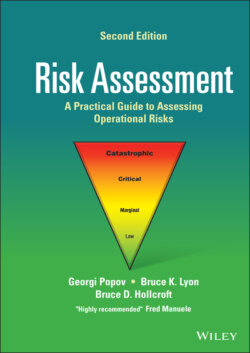Читать книгу Risk Assessment - Georgi Popov - Страница 39
2.6 ANSI Z10.0
ОглавлениеAs the standard states, risk assessment is essential to an organization’s occupation health and safety management system. To begin, a clear understanding of occupational health and safety management systems (OHSMS) is necessary. The American National Standard, ANSI/ASSP Z10.0‐2019, Occupational Health and Safety Management Systems, defines such a systems as “a set of interrelated elements that establish and/or support occupational health and safety policy and objectives, and mechanisms to achieve those objectives in order to continually improve occupational health and safety.” In essence, it is a business system employed by the organization to effectively manage operational risks to enable the organization to achieve its business objectives.
The ANSI Z10 standard was originally approved and published in 2005, and recently revised in 2019. It is consistent with other OHSMS models. Z10 dedicates significant emphasis to risk assessment in sections 6.2 Assessment and Prioritization, 8.3 Risk Assessment, and Annex E8.3 Risk Assessment (informative). Requirements are identified by the word “shall,” while the recommended practices or explanatory notes are described by the word “should.” It requires an organization to establish a risk assessment process as part of an OHSMS.
In section 6.2 of ANSI Z10, it states that “the organizations shall establish a process to assess, prioritize and address its OHSMS issues on an ongoing basis …” The standard goes on to state that organization shall do this by “establishing priorities based on factors such as hazards identified, level of risk, potential for system improvements, fatal and serious injury and illness potential, standards, regulations, feasibility and potential positive and negative business consequences, and identifying causes and contributing factors related to system deficiencies and that lead to hazards and risks” (ANSI Z10.0 2019).
Section 8.3, Risk Assessment specifically states that an organization “shall establish and implement a risk assessment process(es) appropriate to the OHSMS issues identified in Section 8.2 to determine the level of risk and enable prioritization for appropriate actions” (ANSI Z10.0 2019). The standard outlines requirements for identifying and documenting high‐risk jobs and activities and recommends the use of well‐defined qualitative and quantitative methods appropriate for the organization. Annexes E6.2, Assessment and Prioritization and E8.3 Risk Assessment provide informative sections on the risk assessment process and select risk assessment methods.
ANSI Z10 is a consensus standard, meaning that ANSI has verified that the requirements for due process, consensus, and approval criteria have been met in the development of this standard. The use of consensus standards is voluntary; however, they are often incorporated into regulatory compliance standards and citations. ANSI Z10 is an important reference for the safety professional defining the minimum requirements for a health and safety management system with its primary purpose to reduce the risk of occupational injuries, illnesses, and fatalities.
